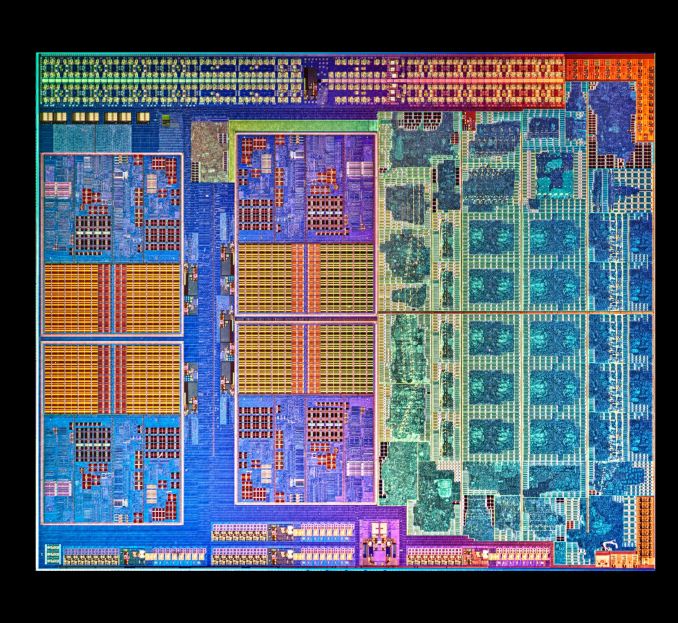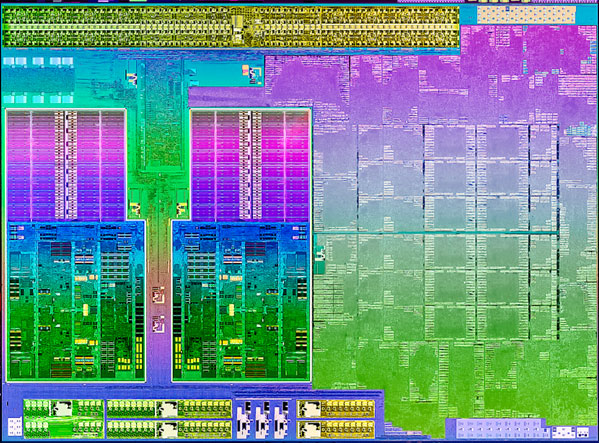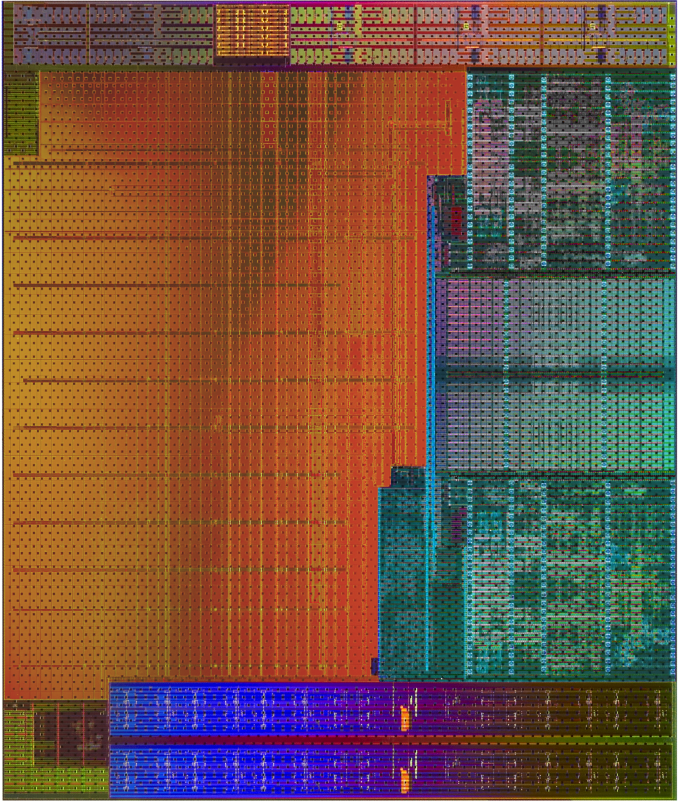AMD Kaveri Review: A8-7600 and A10-7850K Tested
by Ian Cutress & Rahul Garg on January 14, 2014 8:00 AM ESTLlano, Trinity and Kaveri Die: Compared
AMD sent along a high res shot of Kaveri's die. Armed with the same from the previous two generations, we can get a decent idea of the progression of AMD's APUs:
Llano, K10 Quad Core
Trinity and Richland Die, with two Piledriver modules and processor graphics
Kaveri, two modules and processor graphics
Moving from Llano to Trinity, we have the reduction from a fully-fledged quad core system to the dual module layout AMD is keeping with its APU range. Moving from Richland to Kaveri is actually a bigger step than one might imagine:
| AMD APU Details | ||||
| Core Name | Llano | Trinity | Richland | Kaveri |
| Microarch | K10 | Piledriver | Piledriver | Steamroller |
| CPU Example | A8-3850 | A10-5800K | A10-6800K | A10-7850K |
| Threads | 4 | 4 | 4 | 4 |
| Cores | 4 | 2 | 2 | 2 |
| GPU | HD 6550 | HD 7660D | HD 8670D | R7 |
| GPU Arch | VLIW5 | VLIW4 | VLIW4 | GCN 1.1 |
| GPU Cores | 400 | 384 | 384 | 512 |
| Die size / mm2 | 228 | 246 | 246 | 245 |
| Transistors | 1.178 B | 1.303 B | 1.303 B | 2.41 B |
| Power | 100W | 100W | 100W | 95W |
| CPU MHz | 2900 | 3800 | 4100 | 3700 |
| CPU Turbo | N/A | 4200 | 4400 | 4000 |
| L1 Cache |
256KB C$ 256KB D$ |
128KB C$ 64KB D$ |
128KB C$ 64KB D$ |
192KB C$ 64KB D$ |
| L2 Cache | 4 x 1MB | 2 x 2 MB | 2 x 2 MB | 2 x 2 MB |
| Node | 32nm SOI | 32nm SOI | 32nm SOI | 28nm SHP |
| Memory | DDR-1866 | DDR-1866 | DDR-2133 | DDR-2133 |
Looking back at Llano and Trinity/Richland, it's very clear that AMD's APUs on GF's 32nm SOI process had a real issue with transistor density. The table below attempts to put everything in perspective but keep in mind that, outside of Intel, no one does a good job of documenting how they are counting (estimating) transistors. My only hope is AMD's transistor counting methods are consistent across CPU and GPU, although that alone may be wishful thinking:
| Transistor Density Comparison | ||||||||
| Manufacturing Process | Transistor Count | Die Size | Transistors per mm2 | |||||
| AMD Kaveri | GF 28nm SHP | 2.41B | 245 mm2 | 9.837M | ||||
| AMD Richland | GF 32nm SOI | 1.30B | 246 mm2 | 5.285M | ||||
| AMD Llano | GF 32nm SOI | 1.178B | 228 mm2 | 5.166M | ||||
| AMD Bonaire (R7 260X) | TSMC 28nm | 2.08B | 160 mm2 | 13.000M | ||||
| AMD Pitcairn (R7 270/270X) | TSMC 28nm | 2.80B | 212 mm2 | 13.209M | ||||
| AMD Vishera (FX-8350) | GF 32nm SOI | 1.2B | 315 mm2 | 3.810M | ||||
| Intel Haswell 4C (GT2) | Intel 22nm | 1.40B | 177 mm2 | 7.910M | ||||
| NVIDIA GK106 (GTX 660) | TSMC 28nm | 2.54B | 214 mm2 | 11.869M | ||||
If AMD is indeed counting the same way across APUs/GPUs, the move to Kaveri doesn't look all that extreme but rather a good point in between previous APUs and other AMD GCN GPUs. Compared to standalone CPU architectures from AMD, it's clear that the APUs are far more dense thanks to big portions of their die being occupied by a GPU.













380 Comments
View All Comments
Fox5 - Wednesday, January 15, 2014 - link
There's also the issue of the Iris Pro's 128MB edram. At a certain point, it probably is insufficient for the settings and resolution.BSMonitor - Wednesday, January 15, 2014 - link
Power consumption numbers?? Interesting to see what adding that many transistors (particularly 128 GPU cores did to those)Da W - Wednesday, January 15, 2014 - link
242 comments so far. Whatever people say, AMD still interests a lot of people and they have a future ahead of them.thomascheng - Wednesday, January 15, 2014 - link
Lets hope they do well, or we will be stuck with buying $1000 Intel CPUs and Nvidia GPUs.TheJian - Wednesday, January 15, 2014 - link
"For casual gaming, AMD is hitting the nail square on the head in its quest for 1080p gaming at 30 frames per second, albeit generally at lower quality settings."Maybe if they'd said for 1280x1024 gaming your comment would be true. Most of the games have mins at 1080p well below 20, and some even avg below 30. This resolution is NOT playable on these crap chips. Buy a vid card and Intel. Period. I really thought these would be faster, but then the downclock due to process happened. Gains in games where you are STILL unplayable isn't a gain. It is a waste of space to benchmark things you can't actually play at. I would rather have seen a dozen games benched at 1280x1024 and a few you KNOW you could run above 30fps at 1680x1050. 1080p here was pointless. AMD should be derided for even mentioning this res with so many games not even playable at avg fps never mind what happens when you click the MIN button in your charts.
Discrete clearly has long legs, as anyone building one of these machines with the new APUs will quickly realize they need to buy discrete to enhance their gaming. I really don't think the dire situation here at 1080p will change until 20nm or more, where you may at that point have MORE games that CAN run 1080p ok, vs what you see here where it's just a joke today.
The games don't even look the same when turning off every feature possible in the game just to hit 30fps. Do you want your games to look like a nintendo 64, or a PC? They should have grown the die a bit for more gpu, so at least 1680x1050 would be pretty good. I don't see AMD making money on cpus for 2yrs :( That means consoles + gpus have to hold the company up and that won't be enough to keep up with R&D in mobile, gpu, cpu. Consoles sold 7mil so far, so at $10-15 per chip ($100 price? per console assuming 15% margin? if they even get that) we're talking about a max of 105mil profits from consoles for the quarter. If they don't keep selling like it's launch month for the next 12 months I see them slowly getting weaker. They owe GF 200mil, so 4 of these console quarters would be ~400mil which is 1/2 blown on GF fines, and the other 200mil goes to interest on their huge debt each year. They need to make some REAL money on cpu/gpu/mobile or this never gets better right? We know cpu is basically out for 2yrs as they say in this article. OUCH. So gpu/mobile has to make something in those two years or this just gets worse and drivers etc will see more phase 1, 2, 3 fixing crap for ages.
The only impressive thing I saw here was Mantle perf claimed by AMD in BF4. But how many times can you afford $8mil to get this done? I'm sure they amped things up for the first time showcase BF4, but how many times can you even afford $2-4mil for this stuff? And then do you get what the dev said in the AMD APU show (only one BTW), a 20% not being unreasonable for your efforts? Far below $8mil for apparently 45% in BF4 right? Devs will opt for the 2weeks to transfer a game to MOBILE first as NV showed can be done with any openGL game (all ps3, ps4 games, many pc games etc) like Serious Sam3 and Trine2 (most of the time according to anandtech was spent on controls, NOT the porting). Unreal 3 engine ported in 4 (yes...FOUR) days by epic/mozilla and it only took 10 people or so. Dice said 2-3 months on mantle. Devs might do 2 weeks just for more sales to a 1.2B unit market on mobile, they will need PAYMENT to do it for Mantle which gets ZERO extra profits (only makes people happy they bought AMD, no extra cash right?). I really hope ARM takes off on desktops, because we currently have an Intel only race and need someone with CASH to fight them. Bring on K1 (and all it's enemies) and all the games for mobile this will create (ported or new, I don't own a ps3 so I'd buy some of those ported that I can't get now). Since we have no real x86 competition any more we need ARM to pick up AMD's slack.
Novaguy - Wednesday, January 15, 2014 - link
Its going to depend on the settings; other reviewers who did 1080p + low to medium settings demonstrated playable frame rates for the a8 but not the intel igps.mikato - Wednesday, January 15, 2014 - link
Ian/Ryan - This seems wrong - "For the 100W APUs at 1280x1024, there is almost no movement between the Richland and the Trinity APUs, except for Company of Heroes" under "IGP Gaming, 1280x1024". In this particular graph, it shows an improvement from Trinity to Richland and then not much improvement from there to Kaveri, except for Company of Heroes.Ryan Smith - Wednesday, January 15, 2014 - link
Noted and fixed. Thank you.tekphnx - Wednesday, January 15, 2014 - link
Looks like a pretty nice improvement for its intended market, namely the HTPC and casual gaming crowd. Calling the onboard GPU decent at 1080p is a laugh though, as other people have said. For 720p, sure, but not 1080p.Prices have shot up from the previous generation, which is unwelcome. And I very much lament the omission of Steamroller from the FX roadmap as an FX owner myself. AMD shouldn't abandon FX... the least they could have done if they're abandoning FX is to include a 6-core Kaveri part at the top end, but it looks like that's not materializing either.
zodiacsoulmate - Wednesday, January 15, 2014 - link
first 4 pages are way better than the last 4 pages :) anyway a great article i read like half an hour